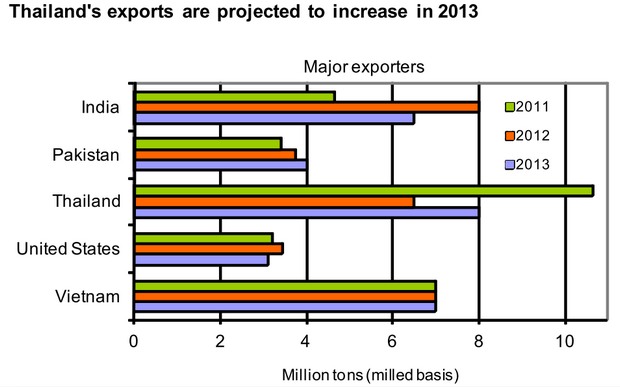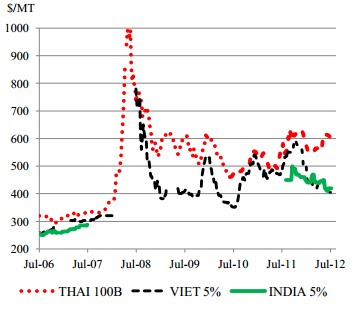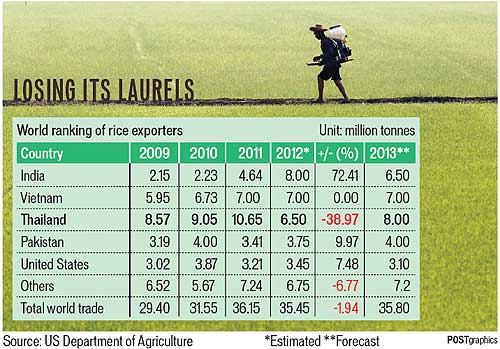US report puts Thai rice edge in doubt
Commerce Ministry maintains confidence
Thailand is set to lose its status as the world's top rice exporter to India, ending nearly 50 years in the top spot, says the US Department of Agriculture.
According to figures released Wednesday by the USDA, Thailand is expected to sell 6.5 million tonnes of rice this year, slipping to third place behind India and Vietnam, which will export 8 million and 7 million tonnes, respectively.
The country in 1965 was proclaimed by the UN Food and Agriculture Organization as the biggest rice exporter with 1.89 million tonnes of rice, replacing the long-time champion, Myanmar.
The USDA said Thailand's rice exports this year will drop by 39% from last year's sales.
Exporters have blamed the populist rice pledging programme of the government for the decline, saying artificially high prices have hurt the competitiveness of Thai rice in the global market.
Prime Minister Yingluck Shinawatra said Thursday that the government will continue the pledging plan and that the Commerce Ministry has a plan to sell the rice.
The government reportedly has spent 250 billion baht to purchase some 17 million tonnes of paddy since the intervention plan began last October.
The programme pays 15,000 baht a tonne for white paddy rice and 20,000 baht for Hom Mali rice.
Commerce Minister Boonsong Teriyapirom remains confident Thailand will export at least 8.5 million tonnes this year, as the government has negotiated with several countries to sell a combined 4-5 million tonnes of rice, with some expected to ship this year.
Mr Boonsong said the government has no plans for now to revise the scheme.
"Thai rice is recognised worldwide as having a better quality than Vietnam rice, so it's reasonable for Thai rice to be quoted higher," he said.
In a separate press briefing, Yanyong Phuangrach, the commerce permanent secretary, voiced confidence that full-year rice exports will reach 9.5 million tonnes.
"Of this, 3 million tonnes will be government-to-government (G-to-G) contracts," he said.
The total includes contracts with Indonesia (1.5 million tonnes), Iraq (660,000 tonnes), Ivory Coast (240,000 tonnes) and various other African countries (2-3 million tonnes) plus 1.5 million tonnes on the premium rice market.
So far, the ministry has yet to export any rice under the G-to-G deals.
With supplies running low, exporters on Wednesday urged the government to sell some of the state's stockpile at a lower cost than it paid under the pledging plan.
They said the private sector hopes to sell 3 million tonnes of rice in the second half of this year after shipping 3.45 million tonnes in the first six months, a 45% drop year-on-year.
Mr Yanyong responded that the government would release its stock on condition that the sales would not affect domestic rice prices and only serve to minimise the expense of keeping stock.
"The pledging programme is aimed at raising rice prices, and the government has achieved that goal," he said. "We do not mind carrying losses."
The export price of 5% white rice was US$585 a tonne as of Thursday, up from $527 a year ago, while the Hom Mali price was $1,084 a tonne from $1,010.
"The previous government's rice income guarantee put a total of 50 billion baht in loss but could not raise rice prices," said Mr Yanyong.
Niphon Poapongsakorn, president of the Thailand Development Research Institute, questioned the sources of locally sold and exported rice.
Thailand produces 30 million tonnes of paddy, but 17-18 million tonnes are in the state's stock, he said.
His suspicion is the pledged and exported rice may have come from Cambodia and Vietnam.
Dr Niphon suggested the government appoint an independent investigation team to check the quality of the rice and make sure none of it was imported to take advantage of high prices under the pledging scheme.




ไม่มีความคิดเห็น:
แสดงความคิดเห็น